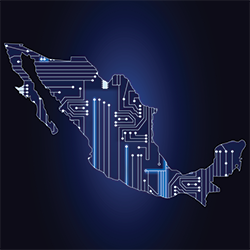 Mexico is known for its rich, ancient culture spanning thousands of years. However, more modern economic, cultural, and political issues limited social and technological development when attempting rapid technological change. Using this as a framing context, authors of “A Brief History of Computing in Mexico” make note of their observations in the delayed reaction to building computing research and development.
Mexico is known for its rich, ancient culture spanning thousands of years. However, more modern economic, cultural, and political issues limited social and technological development when attempting rapid technological change. Using this as a framing context, authors of “A Brief History of Computing in Mexico” make note of their observations in the delayed reaction to building computing research and development.
A Recap of the computing and the internet in Mexico
Under the Adolfo López Mateos and Gustavo Díaz Ordaz presidential eras, Mexico experienced a significant period of technological development. This time was known as the “stabilizing development period,” which saw tremendous growth in the Mexican economy – business investment increased, money savings increased, GDP expanded, and inflation was low.
Want more tech news? Subscribe to ComputingEdge Newsletter Today!
Mexico entered into the computer technology era during this time. In 1958, the National Autonomous University of Mexico (UNAM) was the first institution of higher learning that became interested in acquiring a computer. This computer was used to find “efficient solutions to simultaneous integro-differential equation systems applied to problems that afflicted Mexico City.”
By 1981, Mexico put together a National Plan with the goal of encouraging the development of a computer industry. The focus of this plan was to encourage participation in the computer industry, developing domestic computer businesses.
In the 1990s, the General Agreement on Tariffs and Trades (GATT) and North America Free Trade Agreement (NAFTA) allowed for increased importation of computers. NAFTA ended rates and taxes on hardware and software imports January 2014. However, Mexico was experiencing an economic downturn at the time, inhibiting it from enjoying the benefits of this change. Additionally, NAFTA reduced taxes on assembling equipment. This allowed things like motherboards to be imported from the United States and then be assembled in Mexico.
Mexican Academia
During the internet explosion around 1994, the Mexican education sector was the first to harness this opportunity. Since then, the private and public sectors have caught up to be the primary users of the internet.
The computer era also provided the implementation of long-distance education and the development of personal computers, network, and telecommunications, which allowed the sharing of data, images, and text. Some of the few universities participating in the early 1990s Internet era were the Monterrey Higher Education Technical Institute (ITESM); University of the Americas, Puebla (UDLA, later UDLAP); and Mexico Autonomous National University (UNAM).
Continue reading “A Brief History of Computing in Mexico” to further explore the amazing history of computing and research over the last 70 years as Mexico overcame political and economic challenges, and the greater impact of introducing information technology to the public and private sectors.